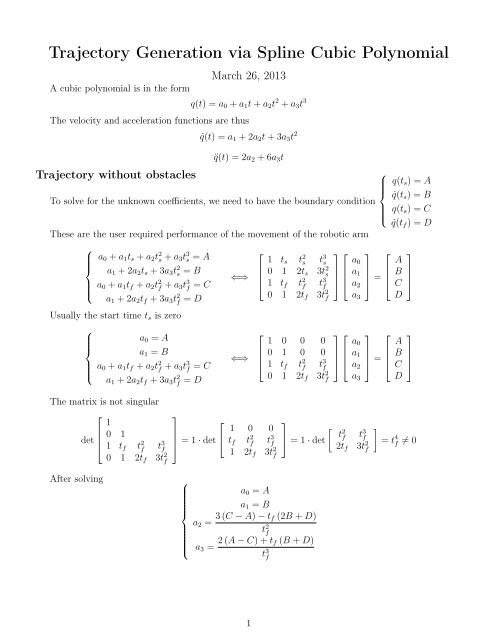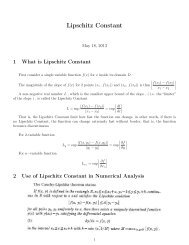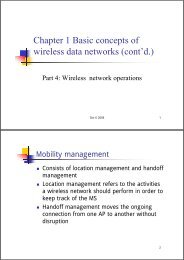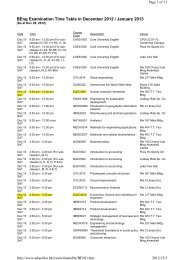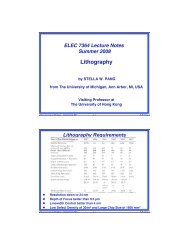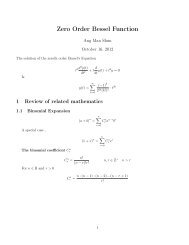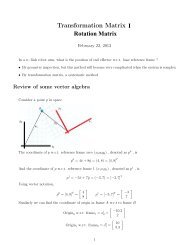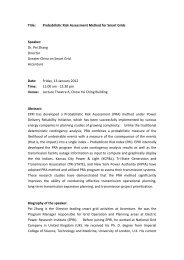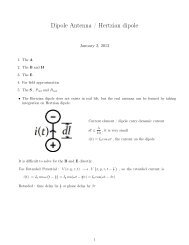Trajectory Generation via Spline Cubic Polynomial
Trajectory Generation via Spline Cubic Polynomial
Trajectory Generation via Spline Cubic Polynomial
Create successful ePaper yourself
Turn your PDF publications into a flip-book with our unique Google optimized e-Paper software.
<strong>Trajectory</strong> <strong>Generation</strong> <strong>via</strong> <strong>Spline</strong> <strong>Cubic</strong> <strong>Polynomial</strong><br />
A cubic polynomial is in the form<br />
March 26, 2013<br />
q(t) = a 0 + a 1 t + a 2 t 2 + a 3 t 3<br />
The velocity and acceleration functions are thus<br />
<strong>Trajectory</strong> without obstacles<br />
˙q(t) = a 1 + 2a 2 t + 3a 3 t 2<br />
¨q(t) = 2a 2 + 6a 3 t<br />
⎧<br />
q(t s ) = A<br />
⎪⎨<br />
˙q(t s ) = B<br />
To solve for the unknown coefficients, we need to have the boundary condition<br />
q(t s ) = C<br />
⎪⎩<br />
˙q(t f ) = D<br />
These are the user required performance of the movement of the robotic arm<br />
⎧<br />
⎪⎨<br />
⎪⎩<br />
a 0 + a 1 t s + a 2 t 2 s + a 3 t 3 s = A<br />
a 1 + 2a 2 t s + 3a 3 t 2 s = B<br />
a 0 + a 1 t f + a 2 t 2 f + a 3t 3 f = C<br />
a 1 + 2a 2 t f + 3a 3 t 2 f = D<br />
Usually the start time t s is zero<br />
⎧<br />
⎪⎨<br />
⎪⎩<br />
a 0 = A<br />
a 1 = B<br />
a 0 + a 1 t f + a 2 t 2 f + a 3t 3 f = C<br />
a 1 + 2a 2 t f + 3a 3 t 2 f = D<br />
⇐⇒<br />
⇐⇒<br />
⎡<br />
⎢<br />
⎣<br />
⎡<br />
⎢<br />
⎣<br />
1 t s t 2 s t 3 s<br />
0 1 2t s 3t 2 s<br />
1 t f t 2 f t 3 f<br />
0 1 2t f 3t 2 f<br />
1 0 0 0<br />
0 1 0 0<br />
1 t f t 2 f t 3 f<br />
0 1 2t f 3t 2 f<br />
⎤ ⎡ ⎤ ⎡<br />
a 0<br />
⎥ ⎢ a 1<br />
⎥<br />
⎦ ⎣ a 2<br />
⎦ = ⎢<br />
⎣<br />
a 3<br />
⎤ ⎡ ⎤ ⎡<br />
a 0<br />
⎥ ⎢ a 1<br />
⎥<br />
⎦ ⎣ a 2<br />
⎦ = ⎢<br />
⎣<br />
a 3<br />
A<br />
B<br />
C<br />
D<br />
A<br />
B<br />
C<br />
D<br />
⎤<br />
⎥<br />
⎦<br />
⎤<br />
⎥<br />
⎦<br />
The matrix is not singular<br />
⎡<br />
1<br />
det ⎢ 0 1<br />
⎣ 1 t f t 2 f t 3 f<br />
0 1 2t f 3t 2 f<br />
⎤<br />
⎡<br />
⎥<br />
⎦ = 1 · det ⎣<br />
1 0 0<br />
t f t 2 f t 3 f<br />
1 2t f 3t 2 f<br />
⎤<br />
⎦ = 1 · det<br />
[ t<br />
2<br />
f t 3 f<br />
2t f 3t 2 f<br />
]<br />
= t 4 f ≠ 0<br />
After solving<br />
⎧<br />
⎪⎨<br />
⎪⎩<br />
a 0 = A<br />
a 1 = B<br />
a 2 = 3 (C − A) − t f (2B + D)<br />
t 2 f<br />
a 3 = 2 (A − C) + t f (B + D)<br />
t 3 f<br />
1
And thus the equation ( displacement, velocity and acceleration ) are<br />
⎧<br />
⎪⎨<br />
⎪⎩<br />
q(t) = A + Bt + 3 (C − A) − t f (2B + D)<br />
t 2 f<br />
˙q(t) = B + 6 (C − A) − 2t f (2B + D)<br />
t 2 f<br />
¨q(t) = 6 (C − A) − 2t f (2B + D)<br />
t 2 f<br />
t 2 + 2 (A − C) + t f (B + D)<br />
t 3<br />
t 3 f<br />
t + 6 (A − C) + 3t f (B + D)<br />
t 2<br />
t 3 f<br />
+ 12 (A − C) + 6t f (B + D)<br />
t<br />
t 3 f<br />
Since usually the initial and final velocity is zero ( stop at both end ), thus in these cases B = D = 0<br />
, and the eqaution reduce to<br />
⎧<br />
⎪⎨<br />
⎪⎩<br />
<strong>Trajectory</strong> with obstacles<br />
3 (C − A)<br />
q(t) = A + t 2 2 (A − C)<br />
+<br />
˙q(t) =<br />
¨q(t) =<br />
t 2 f<br />
t 3 f<br />
6 (C − A) 6 (A − C)<br />
t +<br />
t 2 f<br />
6 (C − A)<br />
t 2 f<br />
+<br />
t 3 f<br />
t 2<br />
12 (A − C)<br />
t<br />
t 3 f<br />
When the trajectory need to avoid some obstacles, that means the trajectory should not pass through<br />
some points.<br />
To make it simple, that means the trajectory should pass through some points that can avoid hitting<br />
the obstacles.<br />
t 3<br />
Suppose in addition to the upper part, now the trajectory has to pass throguh points p 1 at time t p<br />
How to determine the unknown velocity ?<br />
starting point p s p 1 end point p e<br />
displacement known given known<br />
velocity zero ? zero<br />
The most simple idea is to choose the velocity ( they are free variable ) that the acceleration is<br />
continuous in these point.<br />
As acceleration means force, and a drag force that suddenly appear is not good for robotic arm.<br />
Thus first , split the path from one to 2 path<br />
Original path is p s → p e , now p s → p 1 → p e<br />
{<br />
a 0 + a 1 t + a 2 t 2 + a 3 t 3 t ∈ [t s , t p ]<br />
Since there are 2 path, that means there is 2 displacement equations<br />
b 0 + b 1 t + b 2 t 2 + b 3 t 3 t ∈ [t p , t e ]<br />
Let the velocity at time t p be v<br />
Solve the 2 equations, and equal the acceleration equations to solve for the unknowns.<br />
−END−<br />
2


